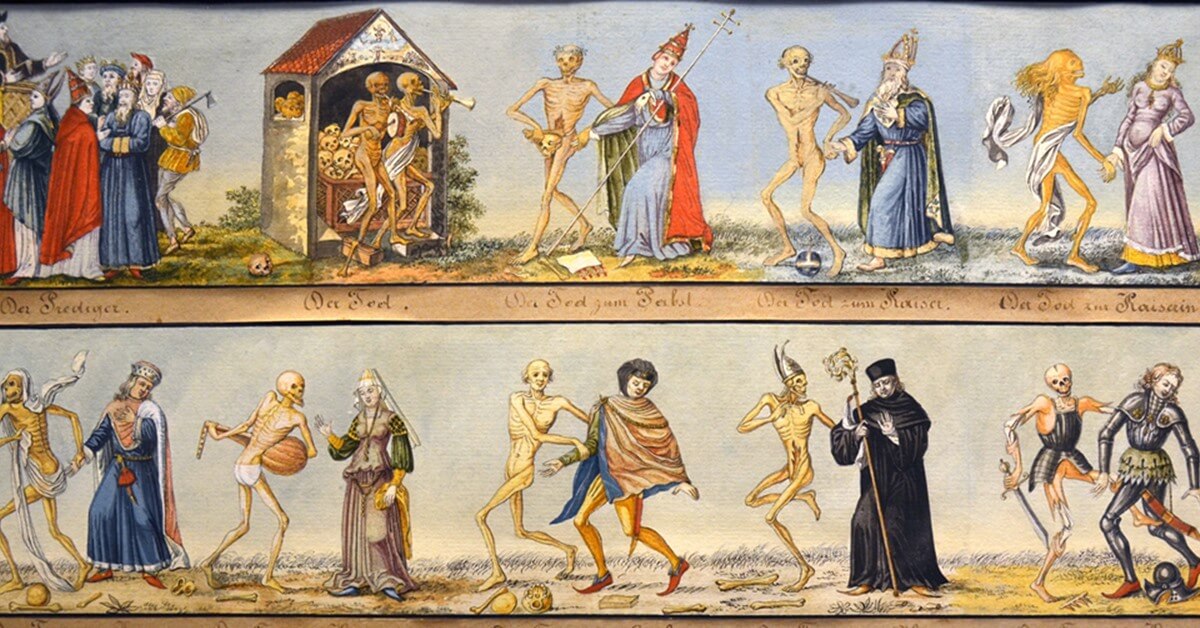
For Western classical music lovers, the words Danse Macabre probably bring the iconic symphonic poem by Camille Saint-Saëns to mind. But, the concept, which is variously known as Danse Macabre, Totentanz or Danza de la Muerte — was once widespread throughout Europe, and became an enduring theme of not only many musical compositions, but poetry, paintings, and more.
The danse macabre comes from the merry old Middle Ages, when the church liked to remind the citizenry that death was always close at hand, no matter what your social station. That’s why many depictions of the theme — Death personified, leading people on a dance to their demise — show popes, kings, and nobles along with peasants.
Among its earliest depictions was a mural in Paris that dates from 1424, demolished in 1669 for urban development, but preserved in memory via woodcuts created in 1485. The dance of death grew into a popular theme throughout the 15th century and into the 16th, and there was even a special version dedicated to women in a print titled Danse Macabres des Femmes.
It remains an enduring theme in art and music through to the present day; one of the tracks to the latest Duran Duran album is titled Danse Macabre.
We’ve selected six pieces from throughout history for your spooky listening pleasure.
Mattasin oder Toden Tanz by August Nörmiger (1598)
August Nörmiger (1560–1613) lived and died in Dresden, Germany, where he lived as a composer and court organist. His piece is performed here by music historian Aria Rita.
Totentanz: Paraphrase on Dies irae, S.126 by Franz Liszt (1849)
The work for piano and orchestra is based on the Gregorian plainchant melody Dies Irae, which he develops through variations that pushed the stylistic limits of the era. Performed live on February 7, 1986 at the Salle Pleyel, Paris by Martha Argerich, piano, and the Orchestre de Paris with conductor Daniel Barenboim.
The Field-marshal from Songs and Dances of Death by Modeste Moussorgsky (1870s)
Russian composer Modest Petrovich Mussorgsky wrote the piece in the mid-1870s to accompany poems written by his relative, Arseny Golenishchev-Kutuzov. With orchestration by Shostakovich, Mussorgsky’s piece is performed here by baritone Dmitri Hvorostovsky with the Orchestre symphonique de Montreal and conductor Charles Dutoit in 1998.
Tot, from Three Songs by Arnold Schönberg, Op. 48 (1933)
In Tot, or Dead, Schönberg uses his 12-tone system to unravel the poetry of Jakob Haringer. The piece was written and published during the tumultuous period where Schönberg and his family escaped the Nazi regime by immigrating to the US.
Totentanz by Thomas Adès (2013)
Thomas Adès conducts his own piece for voices and orchestra based on a 15th century text at its world premiere at the BBC Proms 2013. The BBC Symphony Orchestra performs at Royal Albert Hall, London.
Vito Žuraj – Api-danza macabra (Bee Dance of Death) (2021)
Slovenian composer Vito Žuraj riffs off Rimsky-Korsakov’s iconic Flight of the Bumblebee, but despite its comedic moments, the piece was written to draw attention to the plight of vanishing bees. Performed by the WDR Symphony Orchestra, conducted by Cristian Măcelaru, the commissioned piece premiered the commissioned composition as part of the WDR Minatures of Time on June 25, 2021 at the Kölner Philharmonie. Toronto audiences can hear it performed by Esprit Orchestra on November 30.
Are you looking to promote an event? Have a news tip? Need to know the best events happening this weekend? Send us a note.
#LUDWIGVAN
Get the daily arts news straight to your inbox.



